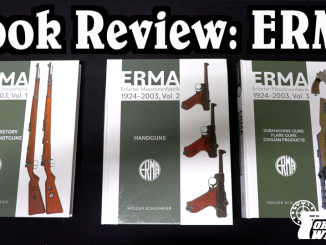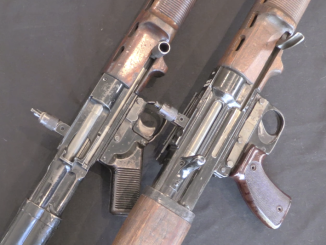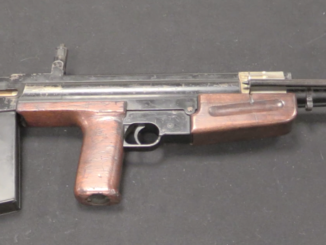The Steyr-Hahn is one of the less glamorized pistols used in WWI, despite being made in quite large numbers (250,000-313,000, depending on who you read). The gun is an interesting mix of features, including bits from the Roth-Steyr M1907 and the early Colt/Browning 1900/1902/1903 pistols. As the M1912, the gun was the standard pistol for the Austro-Hungarian Empire (albeit supplemented with M1907s, M1898 Rast-Gassers, and more) during the Great War. It was also purchased in quantity by Romania, Chile, and Bavaria. We will look at a couple of these variants today, and also an example of the guns converted to 9x19mm for Austrian police forces in the 1940s.
Related Articles

Book Review: ERMA Erfurter Maschinenfabrik 1924–2003 (Three Volumes)
Available from Schiffer Publishing as three separate volumes: https://www.schiffermilitary.com/collections/military-new-releases/products/erma-erfurter-maschinenfabrik-1924-2003-vol-1 https://www.schiffermilitary.com/collections/military-new-releases/products/erma-erfurter-maschinenfabrik-1924-2003-vol-2 https://www.schiffermilitary.com/collections/military-new-releases/products/erma-erfurter-maschinenfabrik-1924-2003-vol-3 Hot off the presses from Schiffer Publishing, we are looking at Holger Schlemeier’s expanded English version of “ERMA: Erfurter Maschinenfabrik, 1924–2003”. This is a […]

Original FG42: A Detailed Comparison of the 1st and 2nd Patterns
Today we are looking at examples of the 1st pattern (Type E) and second pattern (Type G) FG42, comparing their construction and disassembling both to get a close look at the internal differences. Despite sharing […]

The Korsac EM1 – a British/Polish Bullpup FG-42
Armament Research Services (ARES) is a specialist technical intelligence consultancy, offering expertise and analysis to a range of government and non-government entities in the arms and munitions field. For detailed photos of the guns in […]

Do you have any additional information about Steyr 1912/16 and/or Steyr 1912/16 twin-linked as seen here?:
http://miniaturesandcostumes.tumblr.com/post/124270794440/twin-steyr-191216-pistols-with-full-auto
There is a bit information but in Français:
https://fr.wikipedia.org/wiki/Steyr_Hahn_M11/M12/M12_P16
If I understand correctly it was designed for Austro-Hungarian aviators. My question when: i think that P16 might be for 1916 but it might be for 16 cartridge (16 Patronen in Deutsch) as well. 1916 seems quite late for aircraft-sub-machine-gun.
Were these pistol always issued in twin-link configuration or single version was also delivered? Were they delivered to aviator units only or land forces also?
If we mix information from German and Russian pages, we can obtain the following data :
-1915 : high capacity pistol are made for pilots (small batch) with an attachable stock
-1916 : selective fire version M12 P16
-double model is called Doppelpistole M.12
From this point, we can assume people who did received a grun from 1915 batch or standard M12 P16 had a single pistol.
(if we want to know more, we are redirected to an old-looking website to buy eBooks)
A.B.Zhuk stated also standard-capacity (8) selective-fire Steyr-Hahn pistol existed, however noticing that they also have 16 mark pointed by selector lever when in full-auto mode (and 1 when in single). Marking 1 and 16 instead of words make sense if you consider quantity of languages used in Austria-Hungary.
My comments don’t seem to be recorded. If they have appeared anytime soon, disregard this post.
Disregard my first post.
There are some variants of the Steyr-Hahn that never made it. One looks like an expensive target pistol (prototype being sold at James D Julia) and the other has an insane magazine made by Arthur Kottas (Magazine firearm US patent 1451339 A) which seems to have been the step prior to the FN P90’s magazine in concept. Literal clip feeding aside, I think the Steyr-Hahn had a chance at the personal defense market should it have been redesigned for either detachable magazines or a quick-draw shoulder holster… Or am I wrong?
“personal defense market”
But for this Steyr produced other automatic pistol – see Steyr Kipplauf:
http://hungariae.com/Stey08.htm
To be precise two different Steyr Kipplauf automatic pistol exist: bigger in 7,65mm Browning (.32 Auto) as seen in link above and smaller in 6,35mm Browning (.25 Auto):
http://hungariae.com/Stey09.htm
Usual source of additional information: http://hungariae.com/Stey12.htm
See more detailed break down of seral numbers by year and customer.
As Ian says, it is believed but not certain that Karel Krnka was the author although he worked for Roth in Wien at that time. Later after WWI end was employed by Praga a.s. and Zbrojovka Brno. He passed away at relatively young age in 1926.
Hmmm…. Given that rotating barrel pistols mostly disappeared from armories after the Great War, are you surprised? Mauser Nickl designs also faded away…
Rotary barrel requires much more precise machining than Browning tilting barrel.
Depending on design, remember that most rotary barrel automatic pistol are pre-WW2 designs. For modern rotary-barrel design see Russian GSh-18:
http://world.guns.ru/handguns/hg/rus/gsh-1-e.html
I would not go that far with the claim. Both and any system require a ‘degree of precision’ to have interchangeable parts (basis of economical production) and to function reliably (the key above all).
Let’s not forget that Beretta entertained that concept until very recently. One of two main befits which stands above others is the fact that rotary action absorbs substantial amount of recoil energy. Bullet imparts rotary momentum in a direction (typically RH) which is countered by cam direction. Thus much of recoil force is mitigated between concerned parts. True for cost of wear, but anything mechanical is subject to wear.
Manufacturing methods also advanced considerably; look and PX4 for example. I myself attempted to design an market my own vision of this concept. It’s all how you tackle it. Make it cheap to make, make it reliable and you are half way done.
My 6:44 note was for Bojan but I enjoy to discuss with anyone who has a constructive idea.
GSh-18 deserves respect for its unique locking and mainly full two-stack magazine. Very compact design indeed.
“Mauser Nickl designs also faded away”
Should I understand it as Czechoslovakian Pistole vz. 24? If yes then answer is simple: 9x17mm Kurz (.380 Auto) don’t need any locking system.
“rotating barrel pistols mostly disappeared from armories”
For more modern rotating barrel automatic pistols see:
GSh-18
Beretta Px4 Storm
K-100 Grand Power
Right-on Daweo.
K-100 and its derivatives are selling particularly well. Here applies my previous note regarding to finding the ‘right trick’ how to tackle the problem.
I want to add not so modern automatic pistol locked by means of rotation:
Obregón automatic pistol:
http://www.gunsandammo.com/historical/the-45-obregon-pistol-a-mexican-1911/
see 5th photo from top – I don’t see any reason which would make it significantly more expensive than Colt Government to make. Also notice caption under 1st photo from bottom:
The author found the Obregon’s recoil impulse to be significantly different than that of a 1911.
This is a proper reminder; the Obregon pistol.
I cite one important line from Guns&Ammo you refer to:
“As the slide moves rearward, the stud/slot turns the barrel slightly clockwise to free three locking lugs from their recesses in the slide.”
This is the reason why recoil force is reduced. Barrel is forced to turn AGAINST its natural tendency as rotational momentum reaction dictates. Here comes energy absorption. I did some research in past and found (to my surprise) that not all known pistols with this type of lockup work that way. But this is the correct one.
In my view and as I proposed in previous chats the pistol development in country which implemented vz.24 as a standard sidearm took strange turn after WWII.
If anything could have been done while implementing 7.62×25 shot was to either adopt Tokarev’s concept or to brush-up tried and true nickel’s design with different take. One example that rotary locking concept is still viable is the mentioned GP of Slovakia as mentioned by you.
The interesting fact is that when vz. 52 was adopted Soviet just adopted (1951) Makarov automatic pistol firing 9×18 cartridge, so maybe abandoning vz. 52 and designing new automatic pistol for 9×18 would be better.
Sorry Cherndog I left you unanswered; I got latched on Bojan’s suggestion and that had me to address his first.
By now you can read down there what I think on subject of rotary locking on pistols.
“Karel Krnka was the author”
Not true. Steyr-Hahn designer is Konrad Murgthaler not Krnka.
I did not make the claim, although suggestion was in that direction. Thanks for clearing the question.
History tells us that nationality of originator of a particular design is largely irrelevant. One such example would be Pal Kiralyi, who’s designs found full implementation in French small arms many years after he lived.
“nationality of originator of a particular design is largely irrelevant”
Good solution defend itself.
–
Notice that Austria-Hungary in 1900s was multi-national state. Just get Repetierpistole M.7 and who was involved:
Wasa Theodorovic (nationality unknown to me) – initial idea
Karel Krnka (Czech) – further developing
Georg Roth (Austrian) – cartridge, funding
Fegyvergyar (Hungary, Budapest) – factory (one of two)
Vasilije “Vasa” Teodorovic was Serbian
Do you know how these guns were converted to 9mm Luger? Did they make new barrels or just rechamber existing 9mm steyr barrels? If the latter, did they have to cut off some breech end to rechamber it (ie; is the 9mm luger barrel slightly shorter)?
If it was a simple rechamber job, is there a step in the throat where the Steyr round used to headspace off of?
They used new barrels.
According to CIP 9mm Luger has max working pressure at the level of 2350 bar, and 9mm Steyr”s max pressure is 1350 bar. That means the locking lugs will keep more than 0,8 tons greater longitudinal force after conversion to 9mm Luger. Also, locking lugs total area in contact with barrel is very small, only 5-6 mm2, oposite to Browning locking lugs with the total area of cca 20mm2. Because of that barrels steel must be of the high quality and with the well done heat treatment (hardening). If it is not so, the locking lugs will be deformed after only a few shootings. We can conclude: conversion from 9mm Steyr to 9mm Luger is not good option!
Some more detailed information here;http://randyrick.us/AustrianFirearms/pm1912.htm
Thanks for source, Strongarm.
Two experimental pistol, BSA’s .45 ACP and Walther’s Volkpistole, indeed , are simple and strong samples of rotating barrel variety. Some study over their barrel location approach would create very usable pistols.
The Boberg (soon to be Bond) uses the rotating barrel technique. For such small and light pistols in 9 mm parabellum and .45 acp recoil is very managable.
The Steyr 1912 might well have potential for further development
Things to keep
Rotating barrel may well be a keeper, as there’s a potential for getting the bore slightly lower and closer to the trigger finger with rotating compared to a browning tilting barrel design
that has potential benefits for more compact designs and less muzzle climb
Simillarly, striker firing has potential for achieving a better grip angle consistant with the bore line being low down in the hand
and, a smaller grip, as there is no need to fit the mainspring and hammer into the back of the grip.
In terms of manufacture, Glock style rectangular section breech ends of barrels locking into a broached out ejection port are probably the cheapest and simplest.
Internal feed lips are a great feature, though perhaps Takarev executed the idea better, and managed to retain a detachable mag
Stuff to chuck
Hopefully Steyr achieved a stronger slide retaining pin than Colt did, but later Browning slide designs were still to be preferred. Gaston Glock’s take on slide design makes the slide much easier to manufacture, and it still cannot come off the back of the pistol
Stuff to think about adding
Looking at some of the present day short barrel autos, It’s very easy for the barrel to be less than half of the length of the slide
There is therefore a potential pay off in terms of greater barrel length (plus ballistic efficiency and or smaller pistol dimensions, if someone can find a way to reduce the dead length of the back part of the slide.
blow forward, results in NASTY recoil
The Gabbett Fairfax / Boberg / Shevchenko
http://world.guns.ru/handguns/hg/ua/shevchenko-psh-e.html – yes; it’s nasty!
method of pulling rounds out of the back of the mag and feeding them up, needs some serious work to de-bug it
if that is even possible. perhaps it will always remain a very expensive inertia bullet puller
Oh dear,
for some reason I was thinking that the 1912 was striker fired
It’s got a hammer!
You might have been thinking about the Roth-Steyr 1907 there. Yes, striker-fired weapons can be compact and quicker to shoot. The only problem is the user’s trigger finger in the case of a panicked snapshot.
Does anyone know if there’s a US patent for this pistol, or any other patent online?
Is anyone making replicas of the steyr Hahn? I’m new to guns and would like to have one someday